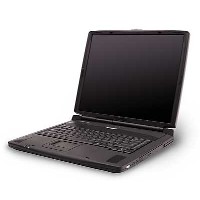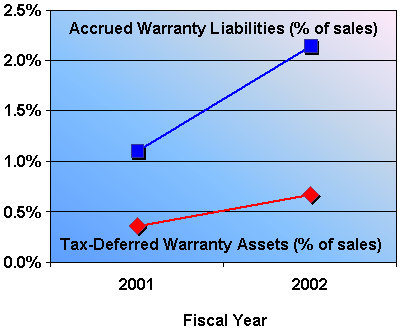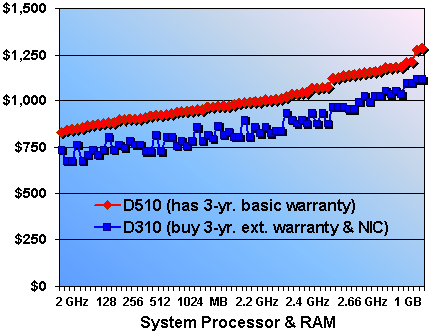May 19, 2003 |
ISSN 1550-9214 |
HP Integrates the Compaq Product Line, and Unites its Warranty and Service Upgrade Options.But extended warranty revenue isn't what it could be, and buyers facing too many choices may instead be choosing to do nothing.by Eric Arnum, Editor
HP, along with IBM Corp., is one of the more diversified desktop and notebook PC manufacturers. Although Dell Inc. is getting deeper into printers and storage, and Gateway Inc. even sells plasma TVs, most of their revenue is derived from sales of laptop and desktop PCs. Not so at HP and IBM, which not only have significant consulting service operations, but also sell very large systems to enterprises. So while Dell and Gateway are somewhat of a "pure play" in terms of microcomputer sales, HP and IBM are not. Furthermore, the process of figuring out historical trends for HP's warranty-related assets and liabilities is complicated by the fact that its merger with Compaq was completed in May 2002 -- smack in the middle of their latest complete fiscal year. Therefore, comparing the warranty figures in their Form 10-K for the fiscal year ended Oct. 31, 2002 with the separate books kept by Compaq and HP in previous fiscal years is not meaningful. In fact, Compaq used to break out very little in the way of warranty cost or revenue. Clues in the Financial StatementsHowever, HP did include a set of pro-forma figures in its annual report that make comparisons as if the companies had merged at the beginning of fiscal 2001. What we can discern from these figures is that extended warranty revenues are on the upswing at HP, but remain low on a percentage-of-sales basis. HP told the Securities and Exchange Commission in Form 10-K that its accrued warranty liabilities in fiscal 2002 neared $1.55 billion, up 73% from $895 million in fiscal 2001. In fiscal 2002, warranty liabilities equaled 2.1% of combined HP and Compaq sales; in 2001 they were 1.1% of combined sales. Since these liabilities accrue more or less as systems are sold, they closely approximate the amount of future warranty costs that HP expects to result from those system sales. Meanwhile, warranty revenue deferred to later tax years -- as is done with extended warranty revenue -- totaled $484 million in fiscal 2002, up 66% from $291 million in fiscal 2001. That equals 0.7% of combined HP and Compaq revenue in 2002, and only 0.4% of combined revenue in 2001. Deferred Revenue on Warranty Contracts | ||||||||||||||||||||||||||||||||||||||||||||||||||||||||||||||||||||||
|
Kenny Stephens, Hewlett-Packard's marketing manager for consumer services, said a lot of the work involved in combining the companies' different warranty, service, and aftermarket operations actually began even before the merger was officially completed on May 3, 2002. "It probably took two to three months organizationally to get us integrated, and so from a policy standpoint, we were integrated by last Fall," he told Warranty Week. "We took a look at both pre-merger Compaq and pre-merger HP policies for consumer notebooks and desktops, and we took a best of both worlds approach." |
|
Consumer PC Warranty Options
Among the changes were a migration of HP's telephone support service from a pay basis over to toll-free, as Compaq provided pre-merger. Likewise, Compaq's free technical support period, which had been set at 90 days pre-merger, was modified to equal the length of the warranty, as was the practice at pre-merger HP. Meanwhile, Hewlett-Packard used to call its extended warranty offers Support Packs. Compaq called its offers CarePaqs. Going forward, the merged company will call all its upgrade offers HP Care Packs.
All the Compaq Presario and HP Pavilion notebook and desktop PCs are now covered by the same one-year parts and labor warranty, with a year of free telephone-based technical support. Upgrades to two years are priced at $85, while upgrades to three years are priced at $100. In each of these cases, the 24x7 toll-free telephone support period is the same as the underlying warranty, whether the problem is in hardware, software, or the user's own abilities. Depending on the underlying system's price, these upgrade offers can equal anywhere from 10% to 18% of total cost.
Broken units can be returned to HP for warranty service, or they can be fixed by a local authorized retailer's own service operation. Turnaround times vary. For small businesses that "cross over" and shop at retail to buy the Pavilions and Presarios instead of the Evo units, HP is testing some new service options aimed at the downtime-averse buyer. But for now, most of the service options for the consumer lines do not come up to the next business day on-site standard that is preferred by business buyers.
Business PC Warranty Options
Within the traditional business PC product line, all but a handful of the low end Evo notebook and desktop PCs are covered by a three-year warranty that also includes a next business day on-site response for repairs to be made under warranty. For the six Evo budget models covered by a one-year warranty, extended warranty options that bring the terms up to three years are priced between $100 and $300 -- lower for the desktops, higher for the laptops.
All of the laptops, be they warranted for one year or three years, also give the buyer the option to purchase accidental damage insurance. These policies will cover the cost of repairs caused by things like droppage and spilled liquids, but they do not typically cover loss or theft.
Prices vary. One laptop with a one-year warranty had an option for a year's accidental damage protection priced at $99. Another with a three-year warranty had three year's of accidental damage protection priced at $169. In fact, some of the laptops have up to nine different extended warranty plans available with varying lengths and terms.
Navigating through those options can be somewhat confusing, but the choices mostly revolve around three key parameters: length of contract (one, two, three or four years), on-site response or customer drop-off, and accidental damage protection or not. The actual permutations available vary from model to model.
Providing Choice
"What we want to provide customers is choice," Stephens said. "Some customers definitely want the peace of mind. There's a percentage of customers that are compelled by our warranty upgrade offerings, and our accidental damage protection services, and will purchase those. For other customers, warranty isn't a top-of-mind issue when they purchase a PC, but we do find that service and support is a huge driver for customer retention."
In fact, in much of his research, be it for printers or PCs, warranty is far down the list of priorities for the initial buyer. They care more about price, speed, brand, and several other aspects. "But when it comes to repurchase," Stephens said, "it's not necessarily the warranty itself but the experience a customer has with that product, of which warranty is a part, that drives a lot of repurchase behavior."
 Like many manufacturers, HP occasionally adds enticements to the product offer in the form of rebates, extra memory, or free peripherals. However, at least in the case of the Presario 6454nx and 6470nx desktops, the current enticement is a free upgrade of the warranty from one year to three.
Like many manufacturers, HP occasionally adds enticements to the product offer in the form of rebates, extra memory, or free peripherals. However, at least in the case of the Presario 6454nx and 6470nx desktops, the current enticement is a free upgrade of the warranty from one year to three.
"We occasionally run promotions where we'll give rebates or we'll give upgrades," Stephens said. "And we do that across the consumer product line, whether it be a scanner, printer, or a PC. We're trying to drive product sales, and we do find that an upgraded warranty will help do that. We find that warranty upgrades are a successful sales tool when bundled with hardware products."
PC Makers Have the Advantage
Stephens noted that his research shows that in the case of PCs, retail customers prefer to purchase their extended warranties from the manufacturer rather than from the storefront or from a third party, because of the bundled telephone support options. Extended warranty providers can cover break/fix issues, but in general they are not as strong on the technical support.
"When you're buying a warranty upgrade through a retailer, it becomes more of an insurance issue. And there's certainly value there," he said, "but I think we're able to offer a more comprehensive service through our warranty upgrades. And then for us, the insurance comes in through the accidental damage coverage."
The desktops and laptops aimed at consumers actually tend to be more powerful than the units aimed at businesses. For instance, it is hard to find a Presario or Pavilion with less than 512 Megabytes of RAM. And because of consumers' appetites for digital music and video, many are typically sold with 80 or even 120 Megabyte disk drives. In very few cases are there identical configurations available in a Presario/Evo pair or a Pavilion/Evo pair. So while we won't draw any conclusions about price differences or warranty coverage, we will note that in the four cases of exact matches, the consumer models were priced hundreds of dollars less.
Price Comparison: D310 vs. D510
Comparisons within the business PC product lines were somewhat easier to make, particularly on the desktop side. The HP Evo D510 Ultra Slim Desktop, the D510 Small Form Factor, the D510 Convertible Minitower, and the D510 e-pc all have three-year limited warranties that cover both parts and labor, and include a next business day on-site response for repairs to be made under warranty. The cost of upgrading that response time to four hours or less (but only during the 9-to-5 business day) is $159. The cost of including nights and weekends into the hours available for a response is $199.
The HP Evo D310 and D310v desktop PCs are sold with a one-year limited warranty that covers both parts and labor, and includes a next business day on-site response for repairs to be made under warranty. A two-year upgrade of that basic warranty costs $69. A three-year upgrade costs $99, and a four-year upgrade costs $249.
The HP Evo D315, although it is part of the budget line, nevertheless has a three-year limited warranty that covers both parts and labor, and includes a next business day on-site response for repairs to be made under warranty. A four-year upgrade of that basic warranty costs $129. A five-year upgrade costs $249.
We compared system prices for the four D510 models and the two D310 models, with a $99 purchase of a three-year extended warranty factored into the price of the latter. This sets the warranty for both product lines equal to three-year terms with next-business-day response, which as was detailed in the May 12 issue of Warranty Week, has become the standard for business buyers.
Adding Options to Equalize Configurations
Also, because the D510 includes a bundled network card (while on the D310 that's a $49 option), we added in the price of a network card along with the extended warranty to the D310's price. This total of $148 in added options for the D310 units set the system configurations of the two lines to as near as equal as was possible.
 It did not, however, set their prices to equal. The D310 line was consistently priced somewhat lower than the D510 line. In fact, the average price difference was $148 and the standard deviation was only $29, meaning that the price variance tended to cluster around that average.
It did not, however, set their prices to equal. The D310 line was consistently priced somewhat lower than the D510 line. In fact, the average price difference was $148 and the standard deviation was only $29, meaning that the price variance tended to cluster around that average.
The D310 product line, which is aimed at the budget-minded buyer, tops out at 2.66 GHz and 1,024 MB RAM, so this was a limiting factor in the comparisons. In 70 different configurations, however, exact matches were made between corresponding identical pairs of D510 and D310 models.
The comparisons basically fell into permutations built around the four available microprocessor clock speeds of 2 GHz, 2.2 GHz, 2.4 GHz, and 2.66 GHz; the four RAM sizes of 128, 256, 512, and 1,024 Megabytes; and two hard drive sizes of 40 and 80 GB. In all, 70 different identical pairs were formed, using 28 different configurations.
Arranged by Ascending Price
The 70 different pairs were arranged by the price of the D510 member of the pair, beginning with a low end of a 2 GHz processor, 128 MB RAM, and 40 GB hard drive, and ending with a high end of a 2.66 GHz processor, 1 GB RAM, and a 40 GB hard drive. Though some models had configurations with even faster processors, more memory, and larger drives, others did not, so identical pairs of a D510 and D310 could not be constructed.
In the chart below, the system configurations along the bottom should be taken as an approximate guide rather than an exact list. As mentioned, 28 different configurations were compared. However, a list of all 28 would have made for a very busy graph, so only a handful of representative steps up in speed and size are listed.
Desktop Price Comparisons:
HP Evo D310 vs. Evo D510
Because the red dots are arranged by increasing price, the chart gives one the false sense that price varies consistently with configuration. In reality, the different permutations of RAM, processor, and hard drive size produce a price line that resembles a sawtooth or a heart rate monitor. Click on the graph above to see a chart where the data is arranged by processor speed, and where the prices are plotted for D510 and D310 system pairs that have no options added.
In both these charts, however, the relationship that matters is between the vertical pairs of blue and red dots. That the blue line never meets the red line demonstrates that even when the two systems are priced with equal warranties, the units that start out with a one-year basic warranty are almost always priced a little lower than those sold with a basic three-year warranty. However, the price differences are not huge, varying from $75 to $196.
HP Price Differences in a Smaller Cluster
In last week's issue of Warranty Week, the price variance for two different Dell desktop PC product lines covered by one- and three-year warranties covered a rather wide swath of -$525 to +$780. Though the average price difference in the Dell comparison was only $145.73 -- lower than HP's $148.30 -- the standard deviation for the Dell data was $256.27, which means it was literally scattered all over the graph.
With the HP data, the standard deviation is only $29.30, which means more than two-thirds of the pairs vary between $119.00 and $177.60 in price. That's a much narrower spread. In the chart above, this strong correlation between the red and blue lines is not exactly smooth, but at least it's visible.
By the look of the chart, the trend is quite clear. The Evo D310 or D310v desktop with an extended warranty is almost always priced lower than the corresponding D510 model with just its basic limited warranty. However, the difference is not enormous, and can probably be accounted by some additional cost-cutting features within the D310 line.
Price Comparison: D310 vs. D315
Just for comparison's sake, we also priced nine identical pairs of Evo D310 and Evo D315 units. Though they're all part of the D300 series, the D315 comes with a three-year basic warranty, like the D510, while the D310 and D310v come with one-year warranties. But like the D310, the network card is optional on the D315.
Of the nine pairs, four favored the D310 while five favored the D315. But the differences were all in a very narrow range of -$40 to +$20 when the warranties set to equal, as opposed to +$59 to +$119 with the one- and three-year warranties left unaltered.
While the nearly identical D510/D310 pairs averaged a $148.30 difference, the nine identical pairs of D315/D310 units averaged a difference of only $7.67 after the price of an extended warranty was added in. This confirms that in fact, the value of the one- and three-year warranties are priced rather exactly into the HP Evo product line, and that warranties are a significant cause of pricing differences between otherwise identical configurations of HP's desktop PCs.
Too Much Choice?
But while HP seems to have the business PC product line well sorted in terms of features and price, in some cases it provides too many options for warranty and service upgrades. The Evo Notebook N800v, for instance, has nine warranty upgrade options priced between $99 and $398. The Evo Notebook N800c has eight. Most of the others have four or five warranty upgrade packages.
On the consumer side, there are less options for warranty and service upgrades, but there are too many models to choose between. HP could easily cut back to three Presario desktop models and two Pavilion desktop models without impacting consumer choice, if it allowed customers to "build your own" as some other manufacturers do.
The bottom line is that HP's own financial statements suggest that too many of its customers are walking away with only a basic manufacturer's warranty in hand. Whether their failure to buy an extended warranty upgrade is the result of too many choices, or whether they simply feel the basic warranty is good enough, is a question best answered by HP's own research. Perhaps retailers siphon off some of the extended warranty revenue with their own in-store plans? Or perhaps consumers who buy at retail have trained themselves to resist all warranty upgrade offers? Either way, HP's extended warranty revenue total has plenty of room to grow as a percentage of sales.
| Back to Part One |

|
This Week’s Warranty Week Headlines | ||
|
Hackers turn Xbox into low-end PCs, despite Microsoft rule that opening the unit voids its warranty. USA Today, May 15, 2003 | ||
|
Hyundai Motor Co. expected to post declining profits, "ballooning costs of its warranty program " cited as major reason. Automotive News, May 9, 2003 | ||
|
Siebel Systems investigated by SEC over allegations of selective financial disclosures to analysts at April 30 dinner. CBS MarketWatch, May 9, 2003 | ||
|
NASDAQ de-lists shares of i2 Technologies Inc.; manufacturing software company is more than a month late with its 2002 annual report; SEC investigation continues into allegedly fraudulent accounting practices. CNET News.com, May 9, 2003 | ||
|
Warrantech Corp. and ACE Property and Casualty (formerly CIGNA) settle all outstanding lawsuits. Press Release, May 7, 2003 | ||
More Warranty Headlines below | ||

|
Warranty Headlines (cont’d) | ||
|
J.D. Power releases 2003 Initial Quality Study for autos sold in U.S.; Toyota, Porsche, BMW and Honda rank highest, while Suzuki, Mercury, Kia and Jaguar are most improved. Press Release, May 6, 2003 | ||
|
Fujitsu Siemens Computers UK increases warranty coverage on select Scenic desktop models from three years to four years. The Register, 6 May 2003 | ||
|
Weak Korean currency pays for Hyundai's and Kia's warranty costs. Forbes, May 6, 2003 | ||
|
Canadian cars are cheaper than U.S., but cross-border warranty issue remains a deterrent to imports. USA Today, May 6, 2003 | ||
|
Dixons attacks warranties row as simplistic. Electronic Telegraph, April 26, 2003 | ||
More Warranty Headlines below | ||
|
|
Warranty Headlines (cont’d) | ||
|
Dixons chief extols new era of customer support. Times of London, April 26, 2003 | ||
|
Dixons CEO refutes profiteering from warranties. Reuters, April 25, 2003 | ||
|
NEW Customer Service Companies, citing "explosive growth," expands Florida contact center, boost employment. Press Release, April 21, 2003 | ||
|
CRM dissatisfaction greatly exaggerated, Aberdeen Group white paper claims. CRMDaily.com, April 21, 2003 | ||
|
Whirlpool Canada signs ServiceBench Inc. to process online warranty claims. Press Release, April 10,2003 | ||
More Warranty Headlines below | ||

|
Warranty Headlines (cont’d) | ||
|
XL Specialized Inc. deploys Active Web Service's ActiveWeb Warranty to satisfy NHTSA TREAD Act Early Warning Reporting compliance. Press Release, April 7, 2003 | ||
|
IBM, SAS join to help automakers comply with TREAD Act regulations. Computerworld, April 3, 2003 | ||
|
PJ Trailers deploys Active Web Service's ActiveWeb Warranty to satisfy NHTSA TREAD Act Early Warning Reporting compliance. Press Release, April 1, 2003 | ||
|
Interstate Manufacturing deploys Active Web Service's ActiveWeb Warranty to satisfy NHTSA TREAD Act Early Warning Reporting compliance. Press Release, April 1, 2003 | ||
|
Insider secrets for PC buyers, Part 10: Warranties and Returns PC World, April 2003 | ||
More Warranty Headlines below | ||

|
Related Articles From Warranty Week |


 Hewlett-Packard Co., a year after its merger with Compaq was completed, has come a long way in terms of integrating the microcomputer product lines. The price lists for its desktop and notebook PCs aimed at businesses and consumers are rather orderly, and the basic manufacturer's warranty is clearly factored into those prices. But as recent financial reports have made plain, its market share is not what it used to be, basic warranty cost is not as low as it could be, and aftermarket warranty/insurance revenue is not as big a percentage of total sales as it already is among its competitors.
Hewlett-Packard Co., a year after its merger with Compaq was completed, has come a long way in terms of integrating the microcomputer product lines. The price lists for its desktop and notebook PCs aimed at businesses and consumers are rather orderly, and the basic manufacturer's warranty is clearly factored into those prices. But as recent financial reports have made plain, its market share is not what it used to be, basic warranty cost is not as low as it could be, and aftermarket warranty/insurance revenue is not as big a percentage of total sales as it already is among its competitors.


